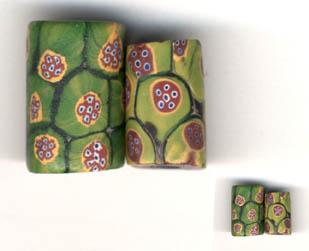The five beads seen here are all pretty unusual. The left specimen has concentric layers, but some of these layers are bicolored. The next bead has canes with layers in which a dark blue band has three colored dots inserted into it. Two are blue and one is red, and there's a larger white cane in the center. Viewed from the right angle, the composition looks something like a simple face. In the third bead, the cane has a yellow and green center, around which have been placed a ring of red/white dots, forming something like a "flower," and similar in effect to a composite cane (number 29) in the Chart. The remaining two beads feature layered canes with outer stripes, in usual color schemes. And, the final bead was made as an ellipsoid and rolled over a shaped surface to make it into a stepped bicone.



